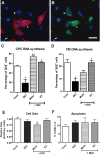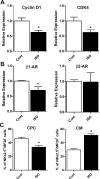Effects of β-adrenergic receptor drugs on embryonic ventricular cell proliferation and differentiation and their impact on donor cell transplantation
- PMID: 28283550
- PMCID: PMC5451577
- DOI: 10.1152/ajpheart.00425.2016
Effects of β-adrenergic receptor drugs on embryonic ventricular cell proliferation and differentiation and their impact on donor cell transplantation
Abstract
β-Adrenergic receptors (β-ARs) and catecholamines are present in rodents as early as embryonic day (E)10.5. However, it is not known whether β-AR signaling plays any role in the proliferation and differentiation of ventricular cells in the embryonic heart. Here, we characterized expression profiles of β-AR subtypes and established dose-response curves for the nonselective β-AR agonist isoproterenol (ISO) in the developing mouse ventricular cells. Furthermore, we investigated the effects of ISO on cell cycle activity and differentiation of cultured E11.5 ventricular cells. ISO treatment significantly reduced tritiated thymidine incorporation and cell proliferation rates in both cardiac progenitor cell and cardiomyocyte populations. The ISO-mediated effects on DNA synthesis could be abolished by cotreatment of E11.5 cultures with either metoprolol (a β1-AR antagonist) or ICI-118,551 (a β2-AR antagonist). In contrast, ISO-mediated effects on cell proliferation could be abolished only by metoprolol. Furthermore, ISO treatment significantly increased the percentage of differentiated cardiomyocytes compared with that in control cultures. Additional experiments revealed that β-AR stimulation leads to downregulation of Erk and Akt phosphorylation followed by significant decreases in cyclin D1 and cyclin-dependent kinase 4 levels in E11.5 ventricular cells. Consistent with in vitro results, we found that chronic stimulation of recipient mice with ISO after intracardiac cell transplantation significantly decreased graft size, whereas metoprolol protected grafts from the inhibitory effects of systemic catecholamines. Collectively, these results underscore the effects of β-AR signaling in cardiac development as well as graft expansion after cell transplantation.NEW & NOTEWORTHY β-Adrenergic receptor (β-AR) stimulation can decrease the proliferation of embryonic ventricular cells in vitro and reduce the graft size after intracardiac cell transplantation. In contrast, β1-AR antagonists can abrogate the antiproliferative effects mediated by β-AR stimulation and increase graft size. These results highlight potential interactions between adrenergic drugs and cell transplantation.
Keywords: donor cells and drug interactions; embryonic ventricular cells; intracardiac cell transplantation; proliferation and differentiation; β-adrenergic receptor drugs.
Copyright © 2017 the American Physiological Society.
Figures









References
MeSH terms
Substances
LinkOut - more resources
Full Text Sources
Other Literature Sources
Molecular Biology Databases
Research Materials
Miscellaneous

